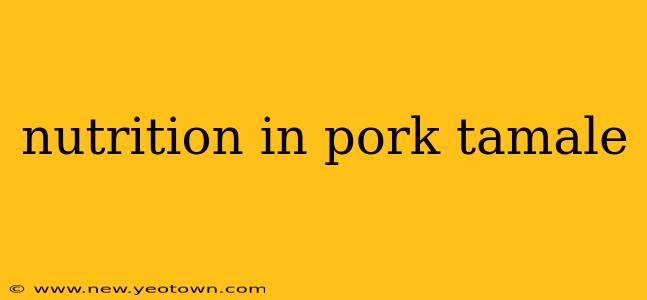Tamales, those savory bundles of corn masa and delicious fillings, are a culinary cornerstone of Latin American cuisine. But beyond their delightful taste and comforting warmth, what's the nutritional story behind a pork tamale? Let's unravel the nutritional secrets within this beloved dish.
What are the nutritional benefits of pork tamales?
The nutritional profile of a pork tamale is a complex tapestry woven from its various ingredients. While not necessarily a health food in the strictest sense, a pork tamale can offer some nutritional benefits, depending on the recipe and preparation method. The corn masa, the foundation of the tamale, provides carbohydrates for energy. Pork, the typical filling, offers protein, essential for building and repairing tissues. Additionally, depending on the additions to the pork filling, you might find vitamins and minerals from vegetables and spices.
However, it's crucial to remember that the nutritional value can significantly vary. The amount of fat, particularly saturated fat, will greatly depend on the type of pork used (lean vs. fatty) and the cooking method. A tamale made with lard will be considerably higher in saturated fat than one made with healthier oils.
How many calories are in a pork tamale?
The calorie count in a single pork tamale is quite variable, ranging anywhere from 200 to 400 calories or more. This fluctuation depends on several factors: the size of the tamale, the amount of pork filling, the type of masa used (some recipes call for additional fat), and the presence of additional ingredients like cheese or sauce. A larger tamale with a rich pork filling and added cheese will naturally have more calories than a smaller, leaner version.
Are pork tamales healthy?
Whether or not pork tamales are considered "healthy" is subjective and depends heavily on individual dietary needs and preferences. In moderation, as part of a balanced diet, they can be enjoyed. However, regular consumption of tamales, particularly those high in saturated fat and sodium, might contribute to weight gain or increased risk of heart disease. A healthier approach would involve choosing leaner cuts of pork, opting for healthier cooking methods (e.g., steaming instead of frying), and incorporating more vegetables into the filling.
What are the ingredients in a pork tamale?
The fundamental ingredients in a pork tamale are the masa (a dough made from nixtamalized corn), the filling (typically pork, but can vary), and the wrapping (corn husks or banana leaves). The pork filling usually includes spices like chili powder, cumin, oregano, and garlic, sometimes along with onions and other vegetables for added flavor and nutrients. Variations exist across regions and families, leading to a wide array of ingredients and flavors.
How can I make pork tamales healthier?
Making healthier pork tamales is entirely achievable with a few mindful adjustments:
- Lean Pork: Opt for lean cuts of pork, trimming away visible fat before cooking.
- Healthy Fats: Replace lard with healthier oils like olive oil or avocado oil.
- Vegetable Boost: Add plenty of vegetables to the pork filling, such as chopped onions, peppers, and corn, to increase the nutritional value and fiber content.
- Portion Control: Be mindful of portion sizes to manage calorie intake.
- Balanced Meal: Enjoy your tamale as part of a balanced meal, incorporating fruits, vegetables, and other nutrient-rich foods.
By making these simple changes, you can enjoy the deliciousness of pork tamales while making them a more nutritious part of your diet. The key is moderation and mindful ingredient choices. Ultimately, the nutritional value of your pork tamale is in your hands!

